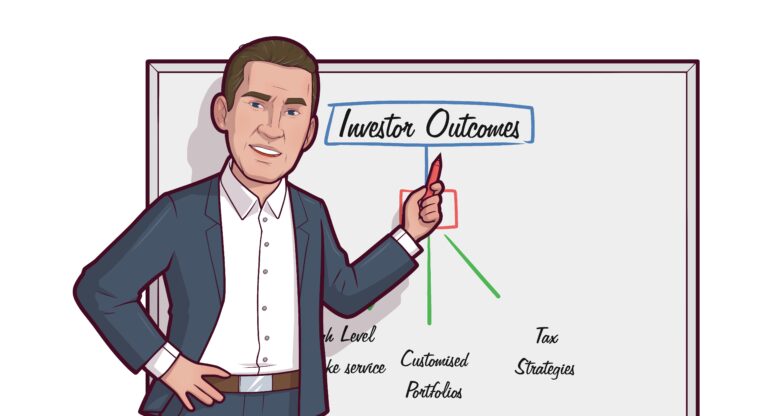This week saw Australian economists blind-sided by another 25 basis point (0.25%) interest rate hike from the Reserve Bank. The official cash rate now stands at 3.85%. Some fixed income managers saw this coming, like Jay Sivapalan at Janus Henderson, but all of the market economists were herding around a consensus of a continued pause in rate hikes.
The new official cash rate was well telegraphed in the media, but less well known are the ‘investable’ rates that are accessible to investors.
In this post we aim to set out the spectrum of interest rates in Australia, from the safest (government bonds) through to some of the more risky high yield fixed interest.
| 6 Months | 1 Year | 2 Years | 3 Years | Other Maturity | |
| Government Bonds | 3.64% | 3.23% | 3.13% | ||
| Challenger Annuities | 4.41% | 4.60% | 4.65% | ||
| Term Deposits (Judo Bank) | 4.60% | 4.75% | 4.70% | 4.80% | |
| Active Credit (Janus Henderson yield to maturity) | 4.53% | ||||
| Active Credit (Daintree Core yield to maturity) | 5.50% | ||||
| Origin Bond (Aug 2027) | 4.51% | ||||
| Aurizon Bond (Dec 2027) | 5.78% | ||||
| Challenger (Sep2027 subordinated debt) | 6.13% | ||||
| Subordinated Bank Debt (HBRD – ETF) | 6.33% | ||||
| Global Credit (Ares CIF yield) | 6.36% | ||||
| Australian Senior Loans (Metrics Credit) | 8.61% | ||||
| First Mortgage Direct Loans | 8.70% | ||||
| Leveraged Private Equity Loans (PGG) | 10.00%+ |
Government Bonds – the most secure asset class
One thing that stands out in the first line is that the most secure fixed interest, government bonds, has a higher return on the short 1 year bonds than the longer term debt of 2 years at 3.23% This indicates the market is already pricing in rate cuts.
Government bonds are one of the few lines of bonds that are available direct to the retail investor. Bonds can be bought on the ASX with any share trading account. This page gives you a link to the list of Treasury Bonds on the ASX: https://www2.asx.com.au/markets/trade-our-cash-market/equity-market-prices/bonds If you click on the hyperlinks in the list, it will give you the specifics of each bond, including a calculated ‘yield to maturity’ if you buy the at the midpoint of the Bid/Offer range. Today, 03/05/2023, the 2.75% coupon treasury bond maturing on 21 APR 2024 is yielding 3.44%.
The advantage of government bonds over term deposits is that the government bond is liquid, and can be sold at any time. However, you do need to know that if a bond is not held to maturity, the net return you get can differ from the quoted ‘yield to maturity’.
Term Deposits – finally some decent rates
Term Deposits are attractive again, and even more so since the last rate hike. The rates I looked at for our table are from Australian Money Market’s Term Deposit broking service. Alex Bank, which is Australia’s newest Approved Deposit taking institution also offers rates that match Judo Bank and deposits are available from as little as $10,000. The rate of 4.75% for a one year deposit is way ahead of what it was a year ago!
Unlike the government bond rates, the longer maturities in Term Deposits are still slightly higher than the short maturities, reflecting a bit more uncertainty. Remember that if you deposit with a bank or credit union or building society that is an Approved Deposit-Taking Institution (ADI) your deposits are guaranteed up to $250,000 per individual or entity.
Investment Grade Corporate Bonds
Corporate bonds are next up the hierarchy in terms of risk and reward. The rate on a Corporate Bond of a given maturity is usually referenced off the risk free government bond rate, plus what is referred to a ‘credit spread’ that represents the additional return that the market requires depending on the risk of the particular corporation. This is not a market that is generally accessed by retail investors, as it is an ‘over the counter’ market that relies on having a ‘custody’ account with one of the big fixed income dealers.
The easy way to buy corporate bonds is through a bond fund, like Janus Henderson Tactical Income, or Daintree Core income. These funds are actively managed to vary their duration and credit exposure according to the outlook of the managers. Janus Henderson has a yield to maturity of 4.53% at the time of writing, while Daintree has a little more risk in the portfolio with a yield to maturity of 5.50%. You can also buy many Exchange Traded Funds that specialise in various sectors of the fixed income market from Government Bonds, to semi-government (state) bonds, to corporate bonds to a diversification of all of the above. Hybrid bank debt can also be purchased via an ETF. The Betashares ETF HBRD is an example, and the current yield on that one including franking credits is around 6.33% p.a.
If you are a Sophisticated Investor (according to Chapter 6D of the Corps Act) you can buy direct corporate bonds. Some of the examples in our table include Aurizon 2027 maturity bond that currently has a 5.78% per annum yield to maturity. Lend Lease have a senior bond that matures in March 2031 with a 6.60% yield.
Un-rated and High Yield bonds
Beyond the government and investment grade corporates, we move into a universe where the loans are either smaller and un-rated by the ratings agencies, or loans that fall outside the favoured ‘investment grade’ rating, which is a BBB rating or above from S&P.
Examples of funds in this category are the Ares Global Credit fund. The fund has 58% of its loans in Investment Grade bonds and loans, but 42% fall outside that. The weighted average credit rating is BB+. The fund has 270 loans overall, with the yield to maturity being 6.36%. Another example is the Metrics Master Income Trust. This is an Australian based specialist direct loan manager, who specialises in secured loans to Australian companies. The level of direct control over business assets and cashflow is what stands these funds apart from a normal un-secured senior debt. Today, the fund MXT.ASX is paying a yield of 8.61% from its portfolio of loans.
Direct Loans
In a different category are direct loans, where the investor can pick and chose who they lend to. Balmain Direct are but one lender in this sector, and we are investigating others lenders who do all the leg work in finding opportunities.
A lot, but not all, loans in this sector are related to future development sites. In this economic environment that adds additional risk. First Mortgage loans with loan to valuation ratios of around 70% can see yields of 8% to 10.5% p.a. net to investors. When investing in direct first mortgage loans it is wise to follow the basic rules of diversification. One deal can look good, but never go all in on one opportunity. There is a lot of decision making involved in building a portfolio of direct loans, but done carefully it can be another source of ‘equity-like’ return with lower volatility.
Special Situations
One of my favoured Private Equity managers is Partners Group. Based in Switzerland, Partners Group are contracted to provide private equity investing for one of Australia’s top three industry super funds. Success in Private Equity is all about building a team that can assess businesses, and build and improve the cashflows of those businesses. This skillset within Partners Group makes me a fan of their Global Income Fund, which is listed under the ASX code PGG. This one is higher risk as it borrows money for its investment portfolio. Currently the gearing is around 40%, meaning that for every $1,000 face value of loans, the trust has borrowed about $400.
The PGG trust is currently trading at a discount to the market value of the underlying loans, and those loans are also marked to a discount on their face (maturity) value. So you are getting a double discount when buying right now. Often, closed end listed trusts like this one can trade at a discount to net asset backing. With the pessimism about the economic outlook, that has certainly been the case here. When the fund first floated on the ASX back in September 2019, the net asset backing was $2.00 per share. Now, with the widening in credit spreads, the net asset backing has dropped to $1.81 per share. In November last year, the share price fell even further, $1.40 per share.
All this while the fund continued to have no losses on any of the underlying loans, and while distributions rose from $0.0087 per month to $0.0125 for the month of March 2023. If we annualise the $0.0125 we get to 15 cents for the year, which is a 9.67% yield based on the $1.55 share price last week. In addition, as the loans mature, (as long as they are ‘money good’ and pay out in full), then there will be additional uplift in the capital value. In their March 2023 report, Partners Group were projecting a 16.6% p.a. return from the portfolio over the next three years.
Now, closed end funds can be a bit of a trap. I love to buy assets at a discount, but if unless there is a catalyst to close that discount you can be a long time waiting for the market to reprice your fund back up to Net Asset Value (NAV).
In the case of PGG, the manager has just announced a solution to close that gap. They propose to have a vote in July for the de-listing of the fund. Investors will then be able to redeem their units at NAV after one year. And, they have promised to make 5% of the fund available each month for redemptions.
News of this change saw the unit price jump from $1.54 to $1.67 on the day of the announcement. For full disclosure, I already have about 6.5% of my own SMSF invested in PGG, and now that there is a pathway to closing the discount I may add some more to that position.
Summary
It has been a long time coming, but finally investors have some decent alternatives to chasing equity yields. Fixed Income funds have been hurt by the rise in rates, but rates now are primed to deliver decent returns on a go forward basis. Be sure to talk to us about the risks of each different option mentioned here. There are flavours to suit the tastes of each risk appetite.


